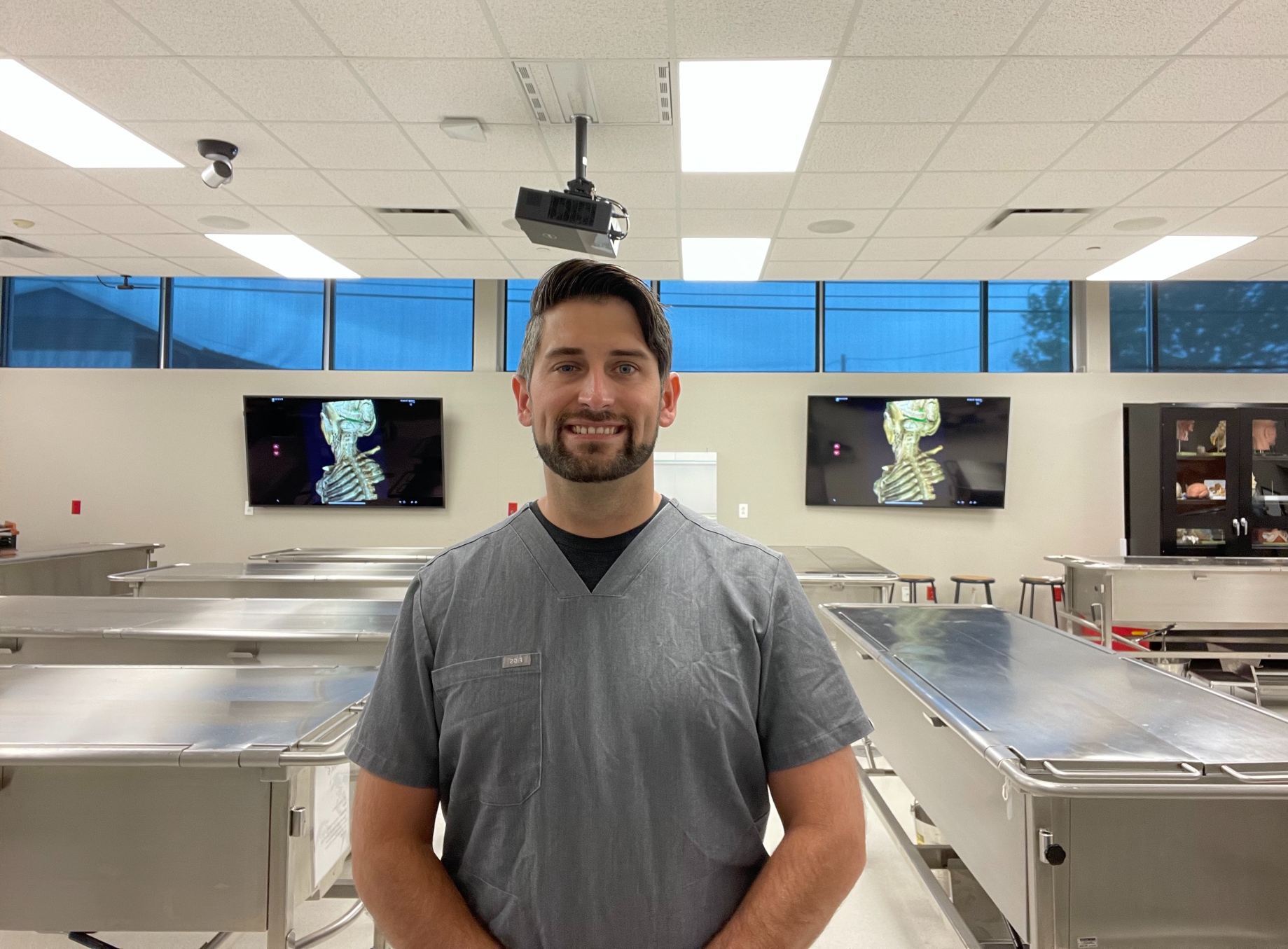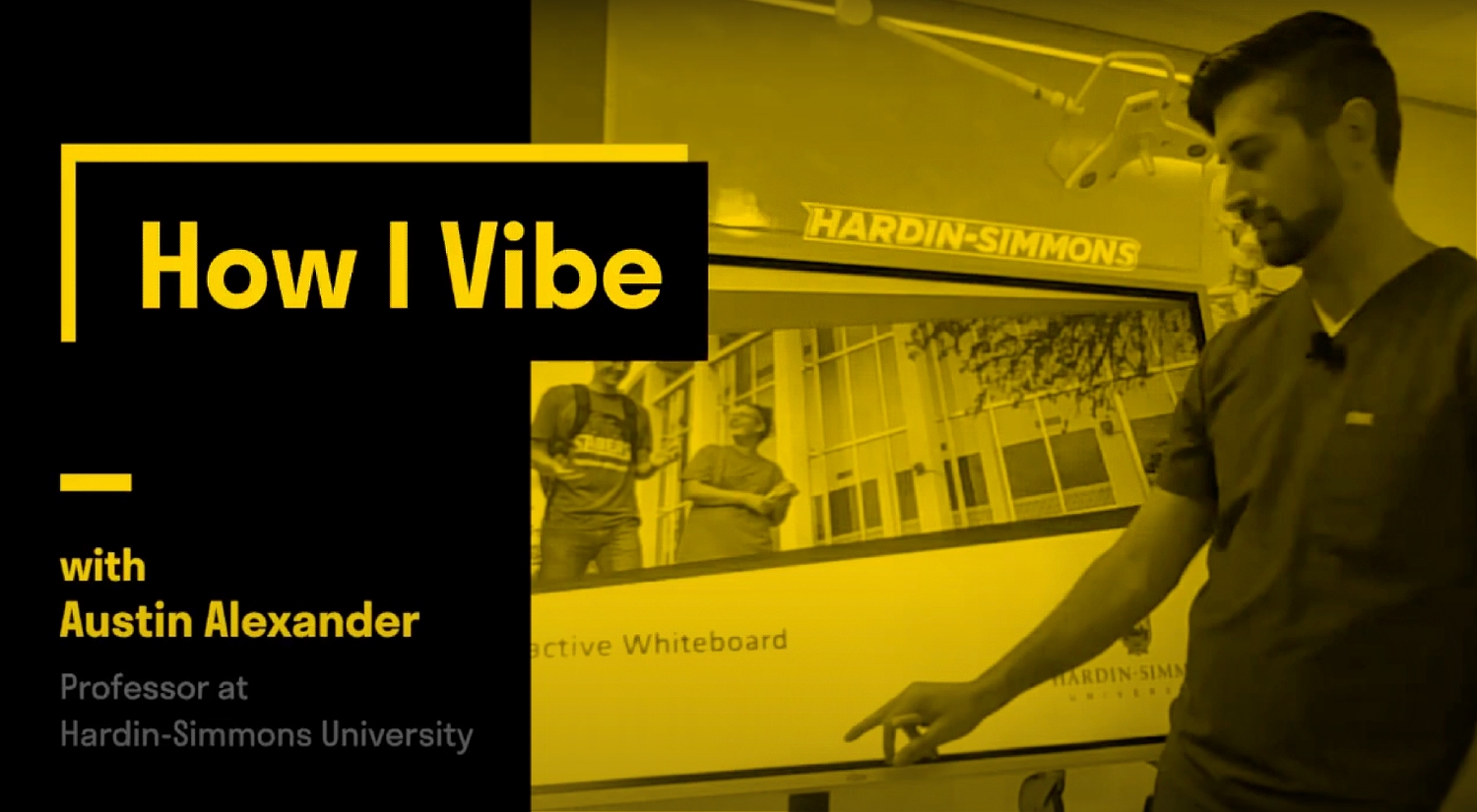Dr. Austin Alexander, PT, DPT, is a licensed physical therapist and assistant professor of anatomy at Hardin-Simmons University as well as an adjunct instructor at Abilene Christian University in Abilene, Texas. Between the two campuses, Alexander primarily teaches anatomy and physiology courses to graduate and undergraduate students in the physical therapy, physician associate, and nurse practitioner programs.
Enrollment at Hardin-Simmons is just over 2,100, including 510 graduate students for the 2020-21 school year. Currently, the school’s physician associate and physical therapy graduate programs admit a total of 70 new students every fall.
The past year demonstrated just how critical healthcare workers are in our everyday lives and in completely unexpected, life-altering situations. Knowing this, Alexander strives to prepare his students for their futures by providing the best learning experience possible. So when he discovered Vibe, he knew it was the exact solution he needed to blend hands-on lab experience with enhanced medical software.
The challenge: replicate hands-on lab experience with technology
Regardless of industry, many jobs require at least some tech competency. Healthcare professionals must be up-to-date on the latest methods, innovative procedures, and technology needed to successfully perform their jobs. Luckily, Alexander has a motivated group of students who he said, “are always looking at YouTube videos; they’re always looking at what else is out there. And I feel like my job as an educator is to be able to find good content and put it in front of them.”
At the undergraduate level, however, there can be challenges to accessing those kinds of tech resources. Many of the challenges aren’t new to the field of education. But the pandemic in 2020 created another barrier.
“When COVID hit, we got pulled out of the cadaver lab and we can’t physically be there. So what can I do to enhance that learning experience?” Alexander asked himself. Additionally, undergraduate students can’t actually participate in cadaver dissection in the state of Texas. So creating a virtual anatomy education was in order.
He started with one brand of anatomy software that he described as, “a virtual cadaver; it’s a web-based software. So I was using that, and using an iPad to teach, and using a computer with a mouse—it’s not quite the same experience as actually getting my hands on [the cadaver]. So I was trying to figure out a way that I could bridge that gap between [hands-on and virtual dissection].”
How Alexander chose the Vibe board
Alexander has been developing grant proposals for the past two years. Consequently, he has completed plenty of research on the kind of technology that’s available for his use case. Whatever he purchased needed to be versatile enough to use in multiple courses and demonstrate value early on. This would help students and staff to easily adopt the technology. Additionally, it would help Alexander make his case more easily when applying for future grants.
Once he saw a Vibe customer study of tennis coach Ian Westermann using the smart board, everything clicked. Alexander immediately saw how he could leverage the Vibe board’s capabilities to teach his students in the anatomy lab.
In an earlier grant proposal, Alexander hoped to secure funds for equipment that cost upwards of $65,000 per unit. While he acknowledged that this item is an impressive and interesting tool, the realization that he could purchase 10 Vibe boards to fully equip his anatomy lab without even spending a total of $65,000 was a game changer. He put the proposal together in less than two months.
“It’s kind of like, this is what I’ve been waiting for, this is what I found; the price point makes sense, and it makes sense for education as well,” Alexander explained.

Using Vibe to enrich the lab experience
Undergraduate students in Texas aren’t permitted to practice cadaver dissection. So it was important to Alexander to get them as close to that kind of experience as possible. To do this, he records videos of himself dissecting and providing instruction, then he launches the Vibe board’s split-screen feature. He then plays the recorded video on one side of the screen while simultaneously bringing up supplemental materials on the other side.
Alexander further explained, “I can use a web-based software that we have a university license for. I open it up on the Vibe board, and now my students actually have their hands—they’re touching it, they’re moving it, they’re zooming in and out, rotating it, all of that. So it’s not the cadaver itself—I don’t think there’s anything out there that’s going to replace cadaver dissection. But partnering the Vibe board and the virtual cadaver dissection is about as close as you can get to the actual, real thing.”
Presenting to professional colleagues
In addition to undergraduate and graduate courses, Hardin-Simmons offers certification courses for licensed clinicians to further their anatomy education. One of their recent certificate courses was the perfect opportunity for Alexander to present while using the Vibe board. He planned on using student feedback to refine his teaching plans for the next class.
Alexander said, “[The clinicians and fellow educators] were all blown away by its versatility. Not just with the ability to incorporate OneDrive and images or videos that I’ve personally taken, but that I can also pull up a web browser and all of fifteen different anatomy resources. I can have it in one space.”
He continued, “I did an hour and a half presentation on the Vibe board, and that was one of the hottest topics of the student evaluation. I think it has a ton of potential and everybody—even the deans that I’ve presented it to—all of them have said, ‘This is one of the most innovative platforms that we can integrate into higher education.’”
Designing lessons without app limitations
For fully immersive teaching, most situations require more than one resource. And educators often use a combination of products from different companies in their lessons. For example, Alexander uses the following when instructing:
- Microsoft suite of products (including OneDrive cloud storage, PowerPoint, Word and Excel)
- Google Chrome as his preferred web browser
- Zoom for video conferences
- Canvas for his learning management system
- YouTube
- Kahoot!
- And various web-based cadaver software programs
With Vibe, he doesn’t have to commit to one software ecosystem. The Vibe board’s open ecosystem makes multi-app usage easier and more accessible than anything else Alexander has researched.
“Pretty much everything I’ve looked into and everything I’ve tried to make this happen as far as cost—I mean, everybody else isn’t even in the ballpark of what Vibe board can be able to do.”
Moving past passive lectures
“Passive lectures are kind of a thing of the past,” Alexander said. The focus in education has shifted to more immersive learning experiences. This kind of learning is especially important in anatomy and physiology classes because many of these students will advance to more complex and hands-on classes en route to careers in medicine and healthcare.
Alexander seamlessly combines both necessary instruction and critically important experiential learning with the Vibe board. He often starts class with a short presentation (either a recording he created while using Vibe or a live lecture). Following that, Alexander presents the class with an engaging assignment. These range from reviewing case scenarios to writing notes directly on the board to completing an assignment separately in the Vibe app. Regardless of the scenario, the interaction is always immediate.
“It’s not, ‘Here’s an assignment, do it and turn it in,’” Alexander said. “It’s an active learning process that gets students engaged and gets them actively thinking, not just passively listening to material.”

Alexander’s favorite Vibe board features
Alexander loves the versatility of the board and the different combinations of apps he can run at the same time. For example, he’ll pull up a PowerPoint, a recording of a cadaver dissection he conducted, and a web browser before beginning his presentation on the brain.
He also frequently uses the annotation feature. Using the Vibe canvas alongside PowerPoint, he’ll write notes as he goes through the slides then email the annotated presentation to himself and his students. Everyone can access the same material, even if they’re not all in the same room.
Essentially, Alexander said the Vibe board, “gives me options. Looking at the applications, you can have almost immediate access once you download them. The versatility to have a ton of content on one device and it’s really simple to use—people with not even a lot of technology experience, once [they] play with it it’s pretty easy to figure out.”
The Vibe board’s intuitive nature is another reason why Alexander thinks every department could benefit from this kind of technology.
“This is something that can be utilized in chemistry, in math—really in any department. Our online education team came in and looked at it and were like, ‘Oh, I want one of these for our office.’ So I think the biggest, number-one benefit is it’s versatile for really any program… I mean, it’s like the sky’s the limit. You can really use it for anything.”
How Vibe can change the future of lab work
The HSU physical therapy department has only had Vibe for a couple months, but Alexander already has bigger plans for anatomy education.
“We’re going to develop it to where it’s a fully functioning undergraduate virtual anatomy lab. Then we’re also going to use [Vibe boards] in the cadaver labs to enhance the cadaver experience with a technology twist to it,” he said.
Alexander has had so much success with Vibe that he said, “I’ve already recommended it to some other universities, and I’ve demonstrated it to almost every program at our university.
Blending real experience with advanced technology
HSU students are already benefiting from the Vibe board, but students at other schools need this kind of experience, too. Alexander thinks every anatomy and physiology student should have access to this kind of versatility and flexibility, particularly when actual cadaver dissection isn’t possible. He wants others in his field to see that technology isn’t the “bad guy.” In fact, something like Vibe “can kind of bridge that gap where it’s real cadavers and it’s technology, blended.” Incorporating technology into the early stages of the medical field sets more students up for success in graduate school.
“Research has found if undergraduate students don’t take three semesters of anatomy education with cadaver dissection, in medical students, there’s not a significant difference in grades from students that [performed dissection] to students that had zero anatomy experience,” Alexander explained. “Which to me, that’s like, we need to revamp. We need to do things differently at the undergraduate level if we’re not seeing a difference in students that have or haven’t taken these courses.”
He continued, “And again…that’s not saying that every institution out there isn’t good. There’s some really great ones in undergraduate anatomy education. But overall, I think as a big thing, we could do better.” And doing better starts with dedicated educators, like Alexander, who are determined to find creative solutions, like Vibe.
Vibe offers a collaborative solution combining an interactive digital whiteboard and innovative smart software. Increase engagement and efficiency at your brainstorming sessions, virtual training, and classroom sessions by integrating your favorite applications with video conferencing and an infinite, mess-free writing canvas. Collaborate today with Vibe.
Looking for the latest in interactive whiteboard technology? Check out Vibe today!
